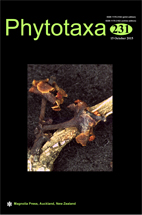Abstract
The hornworts are the smallest group of bryophytes, comprising 10 to 12 genera (Li et al. 2011; Villarreal & Renner 2012; Chantanaorrapint 2014) with approximately 220 species worldwide (Villarreal et al. 2010; Söderström et al. 2015). The status of some species is still unclear and several taxa are yet to be typified (Villarreal et al. 2015). Anthoceros himalayensis Kashyap (1915: 8) was first described by Kashyap from India without designating any type specimen, but was probably based on material collected by himself during a field trip in Mussoorie, Western Himalayas. Furthermore, the figure that accompanies the protologue appears, judging by the shapes of the thalli and the position of the tubers, to include line drawings of two species, namely A. himalayensis and perhaps a Phymatoceros sp. Anthoceros himalayensis was later transferred to the genus Phaeoceros Proskauer (1951: 346) by Proskauer (Bapna & Vyas 1962), however, he had not examined Kashyap’s collection. Attempts to locate Kashyap’s specimens have been problematic. Asthana and Srivastava (1991) also failed to locate the specimen during the study of Indian hornworts. It became necessary to designate a lectotype. Therefore, we here designate Kashyap’s illustration, the Figure 4.4, in the original publication (Kashyap 1915: 8) as the lectotype of Phaeoceros himalayensis (Kashyap) Proskauer (1967: 61) ex Bapna & Vyas (1962: 88) (≡ Anthoceros himalayensis Kashyap). A detailed description, line drawings, and SEM photographs are provided, based on Chopra’s collection from type locality and the recent collections from Thailand.

